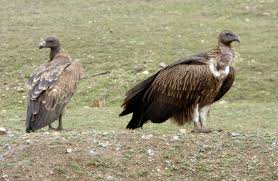AHMEDABAD/NEW DELHI, DECEMBER 3
The number of Gyps vultures in Gujarat has plummeted while it has gone up in Madhya Pradesh, Union Minister of State, Ministry of Environment, Forest and Climate Change (MoEF&CC), Babul Supriyo told the Lok Sabha on November 22.
“The most recent vulture population estimation in Gujarat was carried out in early June 2018. A decline of 75.8 per cent in the Gyps vulture population was recorded in the state between 2005 and 2018,” he said in response to a parliamentary question.
While the vulture population in Gujarat has gone down, their number in Madhya Pradesh has registered an increase.
“The surveys were coordinated by Madhya Pradesh Forest Department and Indian Institute of Forest Management, Bhopal, with support from non-profits. According to the 2019 census, 7,970 vultures belonging to seven species were sighted, marking a 12 per cent increase in the total population,” he said.
Nation-wide vulture surveys are carried out by Bombay Natural History Society every four year, sponsored by the MoEF&CC and the Forest Departments of various states since 1990.
The surveys are carried out mainly for three species of critically endangered resident Gyps vultures, White-backed Vulture, Long-billed Vulture and Slender-billed Vulture.
“These three species were very common in the country, with an estimated population of 40 million in the early eighties. Based on the latest survey carried out in 2015 and the results published in 2017, there were about 6,000 White-backed Vultures, 12,000 Long-billed Vultures and 1,000 Slender-billed Vultures,” Supriyo told Parliament.
The figures of Madhya Pradesh and Gujarat are not from nationwide estimations, according to experts, and should be taken with a pinch of salt.
“The nationwide road transect survey is the most credible one. It involves systematically repeating routes of over 9,000 kilometres across the country. It was due to take place this year, but will now be done in 2020,” said Chris Bowden, programme manager of Saving Asia’s Vultures from Extinction (SAVE), a consortium of 24 organisations working on vulture conservation across South Asia.
“There are challenges of replication of data in all surveys. The nationwide surveys provide the best measure so we await results from that for a better understanding. We warmly welcome state and local surveys, and these are especially important for engagement and raising interest, but some caution is needed in interpreting trends until we have more information from wider surveys,” Bowden added.
Vultures, like tigers, are highly mobile, and therefore, left-behind nests can lead to incorrect estimation of the bird population, he said.

Vulture conservation centre to come up in U P
The Uttar Pradesh Government would set up a conservation and breeding center for the endangered vulture population, officials said.
The centre, first of its kind in the state, would come up in Pharenda area of Maharajganj district, about 269 km east of Lucknow, the capital Uttar Pradesh.
“The centre will be set up in an area of 5 hectares in Gorakhpur forest division,” an official associated with state’s forest department said. “The centre will be set up on the lines of Jatayu Conservation Breeding Centre at Pinjore in neighbouring Haryana.”
Officials said 60 percent of the survey related to conservation and breeding center has been completed.
According to officials, during August this year more than 100 vultures were sighted at Pharenda, the site earmarked for establishing the centre.
Uttar Pradesh principal chief conservator of forests (Wildlife) Sunil Pandey told media the new centre would be set up in association with Bombay Natural History Society (BNHS), a wildlife research organization.
“It will be the first scientific centre of vultures in the state to find out which species is most threatened and the locations where these natural scavengers are thriving,” Pandey said.
A detailed project report of the centre prepared by BNHS has been submitted with the higher authorities for funds, officials said.
According to Uttar Pradesh Wildlife officials, a survey carried out in 2014 across 13 districts of the state put the population of vultures at 900.
The Indian vulture (Gyps indicus) found in India, Pakistan and Nepal has been listed as critically endangered on the International Union for Conservation of Nature (IUCN) Red List since 2002, as the population severely dwindled.
India’s federal environment ministry said in July that a sharp decline in the population of vultures was recorded in the country. The ministry said the population of vultures has come down from 40 million to 19,000 in a span of over three decades.
Figures available with the ministry said the population of three species of endangered resident Gyps vultures – white-backed vulture, long-billed vulture and slender-billed vulture is 6,000, 12,000 and 1,000, respectively.
The decline in India’s vulture population was first noticed in the mid-nineties and by 2007, there was a 99 per cent decline in the population of three resident Gyps species of vultures.
Courtesy: Xinqua












